Fairy Chimneys, Istanbul's Cats, and Turkey's Grand Dame Goes Home at 110.
While we handle our wild current events, a look at a few ravishing wonders might do us some good! Enjoy!

Last week we published the first part of our article on Erdoğan’s autocratic rise in Turkey. In the meantime, we thought we’d let you know that all is not misery in this beautiful place. To that end, we give you three wonders: one geologic, one from the animal kingdom, and the last, one of our favorite humans. Let’s start with the human.
Muazzez İlmiye İtil Çığ
When we first published an article on Dr. Muazzez İlmiye İtil Çığ, arguably the world’s ranking Assyriologist and expert on Sumerian cunieform, the grande dame of Turkish archaeology and ancient languages, she had just turn 108. What slipped past me last August is that, after a long and beautiful life, Çığ had passed away in a private hospital in Istanbul. Tributes to her included this one, offered by here publisher:
"We mourn the loss of Muazzez İlmiye Çığ, a tireless and ageless figure of Turkey's enlightenment struggle, our esteemed scientist, the last ‘Sumerian Queen,’ and beloved author. Our condolences to her family, readers, and the nation."
Every woman should know about this polymath—for she faced off Islamists when they tried to put her in jail for telling academic truth. She won. Here, to inspire every heart, is the story of the longest-living person in the history of Turkey.
Muazzez İlmiye İtil was born in Bursa, Ottoman Empire (now northwestern Turkey) in 1914, just weeks before the outbreak of World War I. Her parents, both Crimean Tatars, moved the family first to İzmir. By the time Muazzez was five, the Greek Army was at the gates of the city, and the family moved again, this time to Çorum. After her grammar school studies, Muazzez returned to Bursa and graduated from its college for elementary school teachers at age 17. She then spent five years as a primary school teacher in Eskişehir.
Then, in 1936, she was off to Ankara University to study French. But all the French classes were already filled, so, on the suggestion of a professor, she took up studies in Archaeology, Hittitology, Assyriology, and Sumerology. Among her teachers were Hans Gustav Güterbock and Benno Landsberger, German Jews fleeing the Third Reich who spent World War II as professors in Turkey. Instantly, Muazzez’s intelligence and gift for ancient languages and cultures became apparent to her teachers—and also came to the attention of Mustafa Kemal Atatürk, the president of Turkey, who personally sponsored and paid for her education.
Soon after graduating, Muazzez went to work at the Topkapi Museum, which was then under the direction of the world-renowned Orientalist M. Kemal Çığ. They married within a year, and Muazzez settled down to become one of the world’s most accomplished translators of ancient Sumerian texts, which were chiseled in cuneiform on thousands upon thousands of clay tablets, many half-broken and in fragments. Largely due to her scholarship, the Topkapi Museum became a learning center for ancient Middle Eastern languages visited by scholars from all over the world.
Çığ retired from the Topkapi in 1972 but continued to do research. She wrote dozens of books, and one of them was called My Reactions as a Citizen. It’s a tad snarky in places and takes issue with the Islamist turn in Turkey. In 2006, during Erdoğan’s first term as prime minister, a conservative Muslim lawyer brought charges against Çığ and her publisher for “inciting religious hatred.”
Çığ was 93 when she went to court. Outside, more than 100 Turkish lawyers and hundreds of Turkish citizens had gathered to show support for her, and fifteen barristers went into chambers with her as defense counsel. It was over in 30 minutes. Her case was dismissed; her publisher was acquitted.
In 2008, during an interview conducted by Daniel Steinvorth, Der Spiegel's Mideast and Turkey editor, Çığ declared unequivocally,
The old cuneiform of the Sumerians describes how sexual rituals with young men were a religious requirement – one of many – for priestesses. These women wore veils over their faces to identify themselves [as temple prostitutes rather than as ritual priestesses]. This is a historic fact. I'm a scientist. Whether this article of clothing, a sex symbol, is suitable as a moral calling card today is something for others to decide.
Muazzez Ilmiye Çığ is, in these days, known in Turkey as one of its strongest defenders of secularism and women’s rights. She has also publicly criticized Erdoğan’s wife Emine for veiling. It’s a bad influence, Çığ says.
Occasionally someone asks if Çığ is really still alive or whether someone is having us on. When this happens, Çığ fires off a cryptic Algonquin Round Table retort, and everyone laughs. … Then they grow quiet and thank God (again) that this Global Treasure is still with us.
The Beloved Cats of Istanbul
There are no rats in Istanbul. Their libraries, some more than 1,000 years old, are intact. There’s a reason for that.
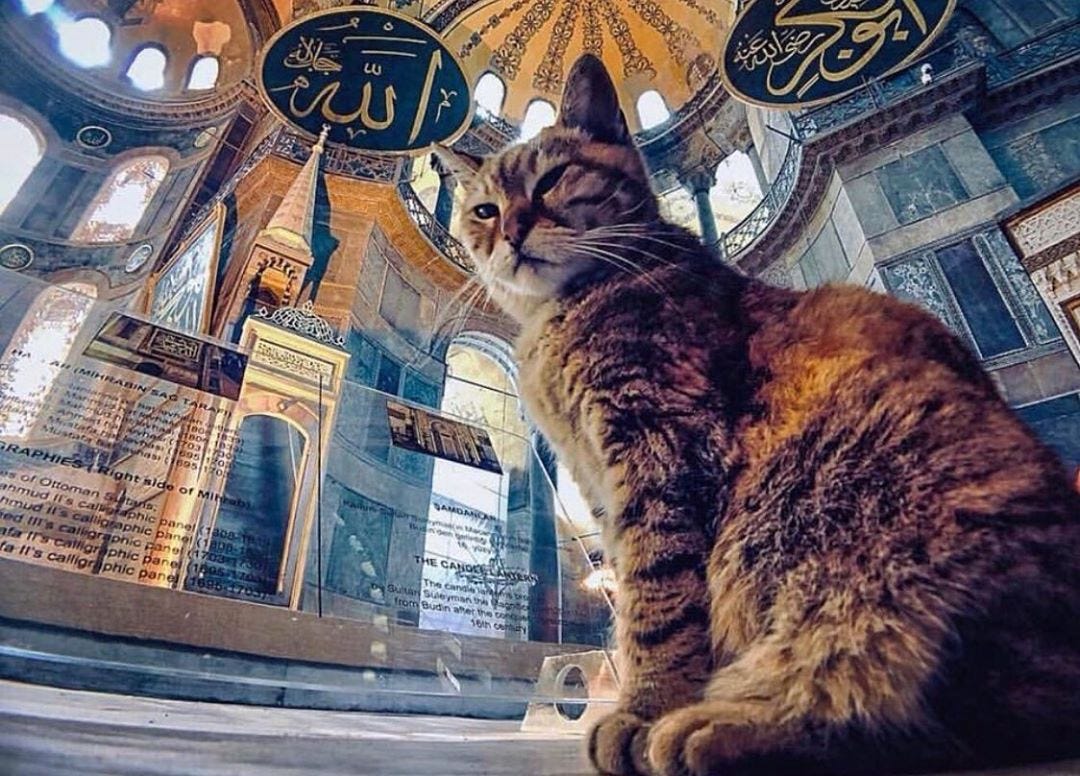
It would be inaccurate to call them strays. The term feral is a downright insult and completely unfair. Istanbul, a mega-city of 15,000,000 people, has a “street cat” population that may top a million little fuzzballs.
They’re everywhere. They’re all over the streets. They inhabit any house they like. They panhandle in fish shops with impunity. There are “hostels” for cats who need to have an indoor bivvy for a day or two. And when there’s a bad storm in Istanbul, shop keepers open their doors and let the cats in for the night. You’ll find them curled up on your restaurant table at dinner. You’re likely to find them, even a dozen of them, sprawled on nice, cushy Oriental carpets and piles of gorgeous silk fabric or curled up in urns at the bazaar.
And they are not hungry. In Turkey, some people do own pets privately, but as a cultural convention, Turkish people believe that pets are public property and everyone’s personal responsibility. Everyone feeds them. If someone finds a sick cat, it’s scooped up and taken to a government-run animal hospital, which treats and vaccinates the feline and then returns her to the precise spot where she was found so that she experiences as little stress as possible. There is a strict “no kill—no capture” legal code in Turkey, so there’s no caging and no euthanasia.
And nobody’s bothered? Well, perhaps occasionally, but as Turkey is largely Islamic, cats get the royal treatment, especially in mosques. Gli, the cat pictured above, was the top cat in the Hagia Sophia. A suggestion that he be removed was met by glowering scowls from worshippers, who considered it an insult to the Prophet Muhammad. In a 2017 issue, a staff writer for The Economist explained this reaction:
Turkey is not unique among predominantly Muslim countries for honouring its cats, which are considered ritually clean animals in Islam. In the hadith, the collected sayings and actions of Muhammad, there are numerous examples of the Prophet’s fondness for cats. By one account, Muhammad cut off his sleeve when he had to rise for prayers so as to not disturb a feline that had curled up on his robe for a nap. In another tale, the pet cat of Abu Hurayrah (literally “father of the kitten”) saved Muhammad from an attack by a deadly serpent. Muhammad purportedly blessed the cat in gratitude, giving cats the ability to always land on their feet. Cats were considered guardians in other respects for the Islamic world: they defended libraries from destruction by mice and may have helped protect city populations from rat-borne plagues.
And so, Istanbul is a city that loves its cats and has created a haven and a heaven for them. The glittering emerald eyes of Gli, who died in 2020, tell you why.
The Fairy Chimneys of Cappadocia
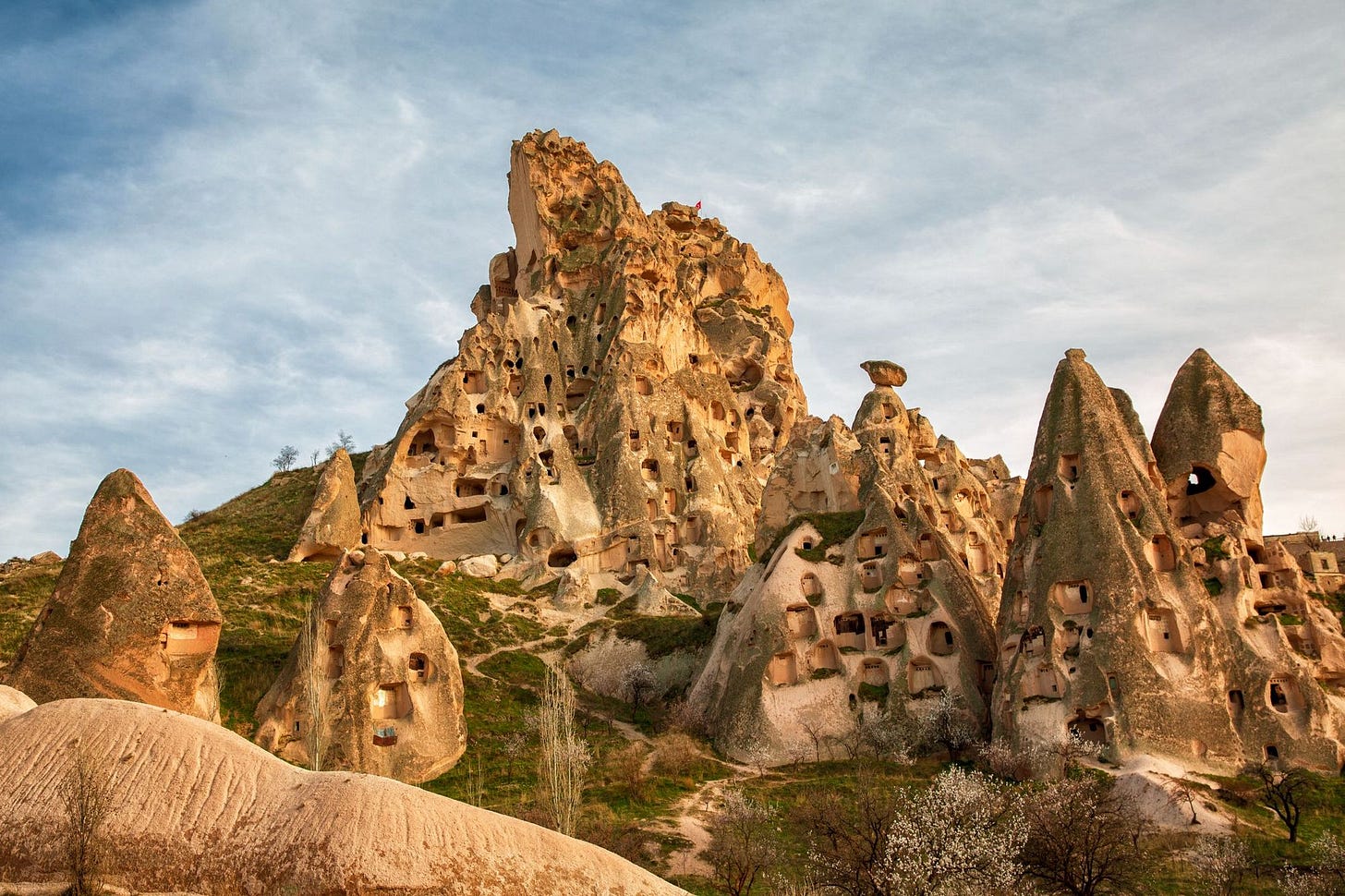
They were millions of years in the making, and they have come down to us as an enchanted and otherworldly landscape. They look like shapes fashioned of pixie dust. However, the Smithsonian opted for the scientific explanation:
Volcanic eruptions rained ash across what would eventually become Turkey. That ash hardened into tuff, a porous rock, which was covered by a layer of basalt. Finally, the long work of erosion began. As millennia passed, the softer tuff wore down, giving way to pillars that stand as tall as 130 feet. The harder basalt erodes more slowly, forming a protective, mushroom-shaped cap over each one. Just like that, a fairy chimney is born—no pixie dust required.
The earliest mentions of Cappadocia appear in ancient Hebrew texts; later, Herodotus picks up the story. During the Roman period, persecuted Christians fled to Cappadocia (more specifically the town of Göreme) and soon realized that the tuff was incredibly malleable. The émigrés sculpted a brilliant matrix of hand-hewn caves, living quarters, churches, stables, and storehouses, all dug into the soft rock.
These were times of great terror, and there was no place safe from invasion. Thus the crafty inhabitants of the fairy chimneys dug 10 storeys into the ground, creating subterranean strongholds that could hide as many as 10,000 people at once. Large rolling stones sealed off their refuges, and the surface intakes for their intricate system of ventilation shafts were disguised as wells.
But times have changed, and now the streets of Göreme are filled with bazaars selling exquisite weavings and fabrics and carpets, and its skies are filled with hot-air balloons—for there are hundreds, thousands of balloons here.

Perhaps the Smithsonian doesn’t think pixie dust had a hand in creating this place, but no one can believe there is no magic here. It is enchanted. Suspicions remain high that spells were cast.
Thank you for reading PolitiSage. You do us great honor. Please share us with your friends.


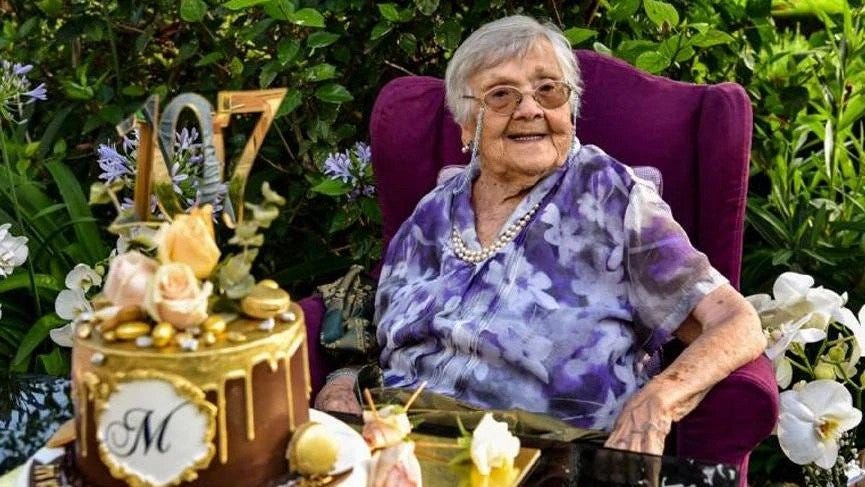
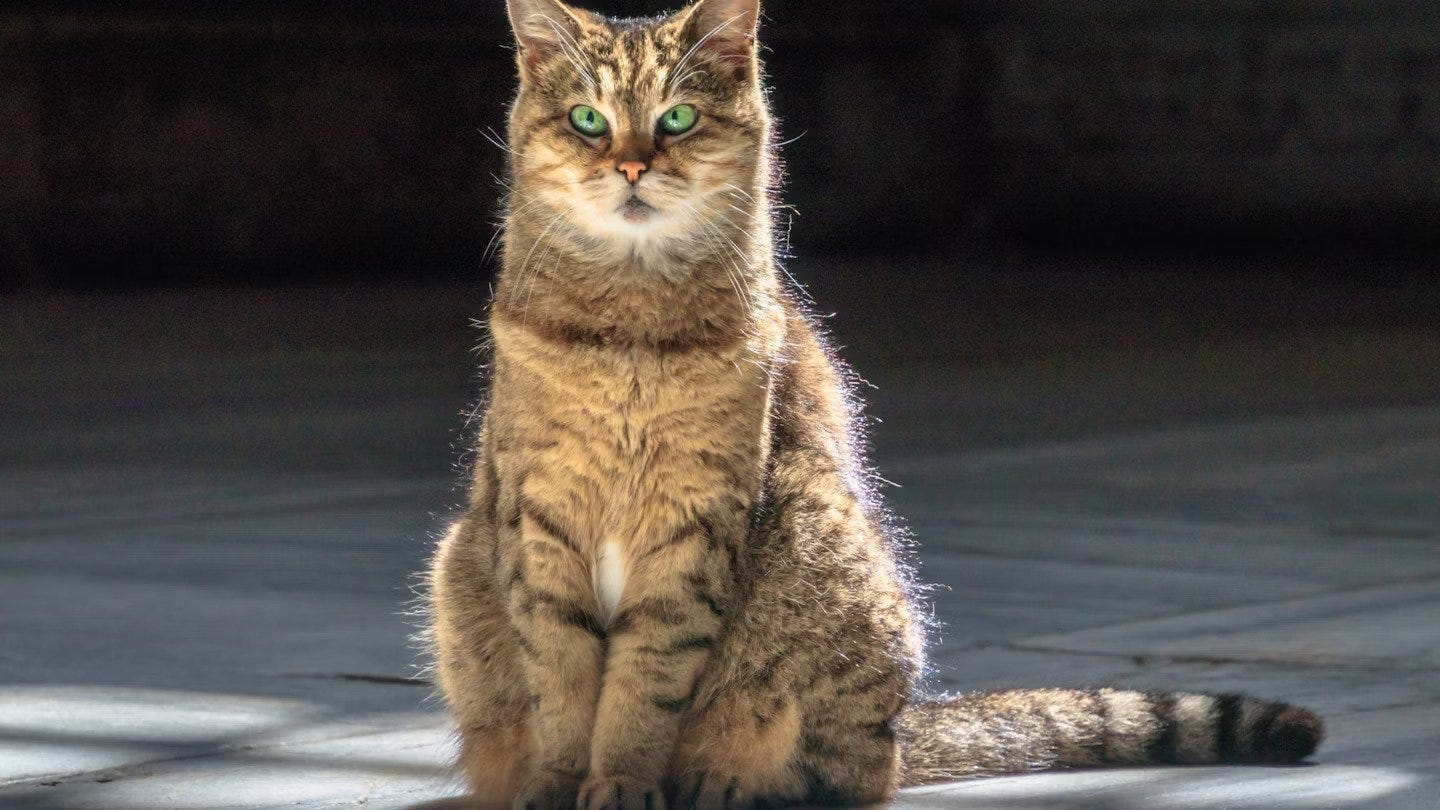
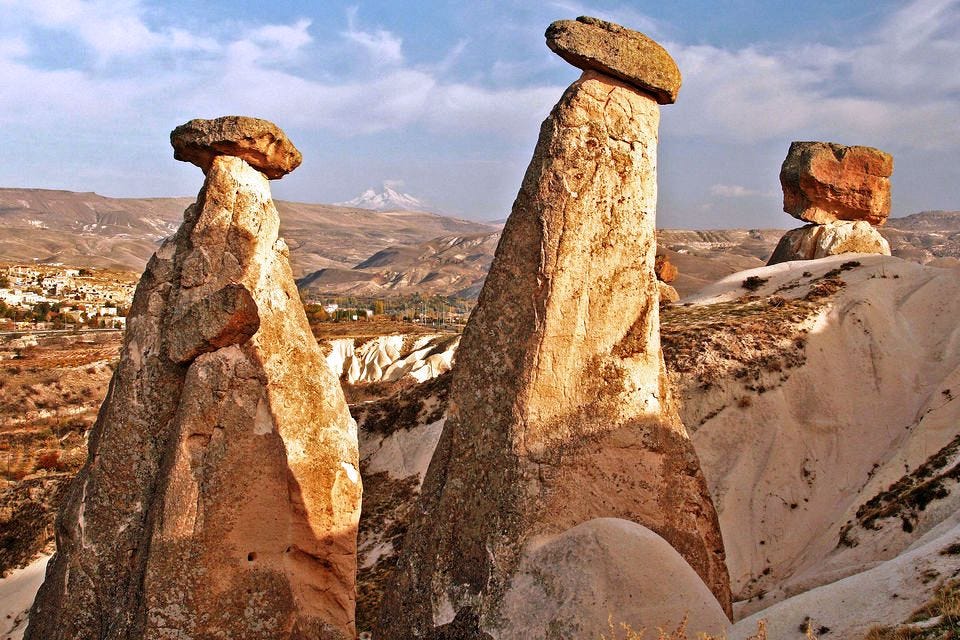
Cig and Gli all in one story! Magnificent!!
Thank you for the wonderfully informative stories about Turkiye’s cats, its oldest woman and its fairy chimneys. I was in Istanbul and Kusadasi, almost ten years ago, a month before the coup. I remember all the cats, everywhere. They were so well kept. I liked how they went everywhere and weren’t afraid of people. They lived like little kings and queens. And Mrs. Cig living to 110. What a long and productive life she lived. I hope one day to go back there to see Cappadocia and other parts that I didn’t get to visit..